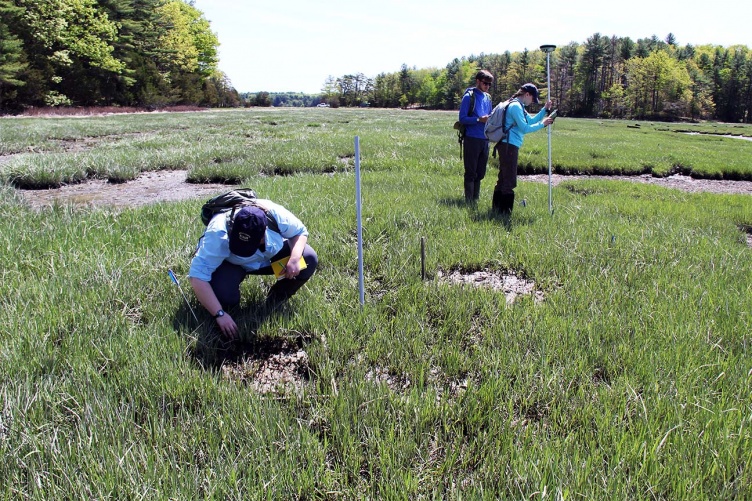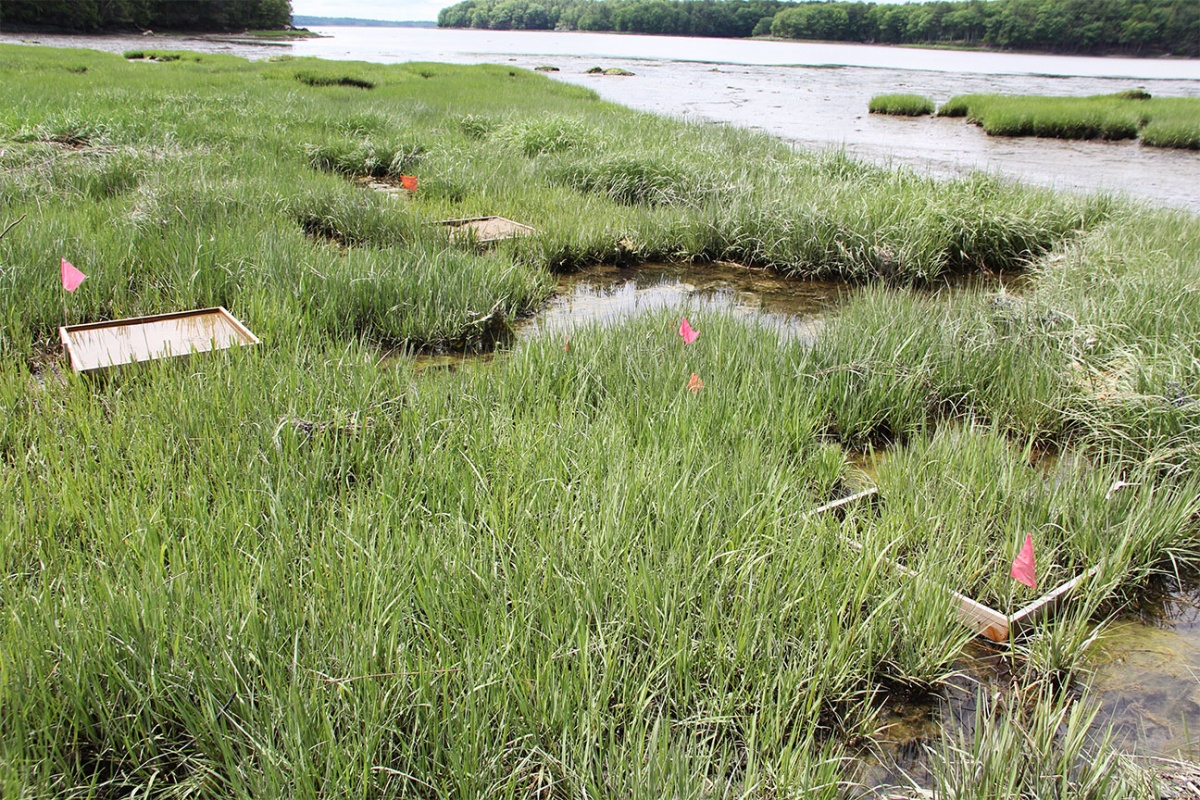
UNH graduate and undergraduate students examine experimental thin-layer sediment plots located at Great Bay National Estuarine Research Reserve.
Key Finding:
TLP strategies can help prevent salt marsh loss by increasing the vertical height of marshland. Knowing how much sediment to add can guide restoration efforts and support long-term marsh resilience. A national team of scientists found that thicker layers of sediment resulted in the same amount of plant growth and crab colonization over three years (when compared with thinner layers) and thus offered the greatest long-term protection of marshland against rapidly rising sea levels.
Key Terms:
Great Bay Estuary, New Hampshire: The Granite State’s largest estuarine system, encompassing more than 10,000 protected acres and including Great and Little Bays in the Seacoast Region.
Marsh Resilience: A measure of how vulnerable marshes are to changing climate and environmental conditions.
Thin-layer sediment placement (TLP): A strategy for restoring or maintaining tidal marsh function and coastal resilience that involves adding new sediment and raising the elevation of the marsh surface.
Tidal salt marsh: Tidal salt marshes, also known as salt marshes and tidal wetlands, are coastal wetlands that are flooded and drained by salt water brought in by the tides. They are often composed of deep mud and peat. They typically occur in middle to high latitudes. (NOAA.gov)
Tidal marshes play important ecological roles along coastlines, including acting as a nursery habitat for commercially fished species, providing shoreline protection from storms and improving water quality by removing pollutants and contaminants. However, rising sea levels caused by increased temperatures and other climate changes threaten tidal marshes worldwide, among them New England’s largest continuous tidal salt marsh, the Great Marsh, which stretches from southeastern New Hampshire to Cape Ann in Massachusetts. New research from national team of scientists, including researchers from the University of New Hampshire’s Jackson Estuarine Laboratory, found that eroded tidal marsh sites can be revitalized by strategic sediment deposits.
Gregg Moore, an associate professor of biological sciences, and David Burdick, director of the Jackson Estuarine Lab and a research associate professor with the natural resources and the environment department, are co-authors on the paper, which was recently published in the international journal Estuaries and Coasts. In addition to working with partners at the Great Bay National Estuarine Research Reserve (GBNERR), Moore and Burdick collaborated with researchers from 13 other universities and agencies located along both U.S. coasts and the Great Lakes. The 3-year study included experimental data from eight U.S. National Estuarine Research Reserves (NERR), among them GBNERR located in Greenland, N.H.
“The vertical range that supports salt marsh is generally less than 6 feet, so if sea levels rise 6 feet by 2,100, almost none of our marshes will remain,” said Burdick. “This is definitely an existential threat.”
“TLP, or thin-layer sediment placement, is an alternative management strategy that can keep marshes healthy and protect uplands from erosion and flooding,” he added.
At each NERR experiment site, scientists tested different thin-layer sediment placement (TLP) treatments. TLP focuses on increasing the height of the marsh by using sediment pulled from areas both on land and the water. At each site, researchers established test plots in both low marsh and high marsh and added either 7 cm or 14 cm of new sediment. They then observed the results over three years.

What they found was that sediment quarried from other on-land areas (instead of dredged from the water) supported marsh plant growth — in some cases better than dredged sediment — meaning TLP can support restoration in marshes farther away from dredge sites. They learned that plant growth and crab colonization generally occurred quickly following the addition of new sediment and that TLP can work just as effectively across high marsh areas, which are rarely flooded by tidal waters, as it can on low marshes, which are regularly flooded by tidal waters. In the past, most TLP research has centered on low marshes.
The scientists also learned that while plants grew faster and crabs more quickly colonized the plots with thinner sediment layers, by the end of three years the thicker and thinner layers had roughly the same number of plants and crabs. This suggests that, in the face of accelerated sea-level rise, thicker layers will provide greater marsh resilience over a longer time period.



Low marsh thin-layer sediment placement (TLP) test plots located at Great Bay National Estuarine Research Reserve. From left, 1) plot immediately after establishment, 2) plot after 1 year and 3) plot after 3 years.
Many places around the country have successfully implemented TLP strategies, however, this technique hasn’t been widely used in New England. The data from this study will better inform an actionable TLP approach in the region.
“There are several isolated marsh areas in Great Bay that are particularly vulnerable to drowning due to rapid rates of sea level rise,” explained Moore. “This work provides immediately applicable data to suggest that, when scaled up, TLP can improve marsh resilience.”
“With the results of our new study, perhaps it’s time for our region to start to seriously consider TLP restoration before our more vulnerable marshes disappear entirely.”
“With the results of our new study, perhaps it’s time for our region to start to seriously consider TLP restoration before our more vulnerable marshes disappear entirely.”
This work was sponsored by the National Estuarine Research Reserve System Science Collaborative. Christopher Peter and Rachel Stevens of GBNERR provided local support and leadership on this project.
You can read the published article, Evaluating Thin‑Layer Sediment Placement as a Tool for Enhancing Tidal Marsh Resilience: A Coordinated Experiment Across Eight US National Estuarine Research Reserves, in Estuaries and Coasts journal.
-
Written By:
Nicholas Gosling '06 | COLSA/NH Agricultural Experiment Station | nicholas.gosling@unh.edu

















































